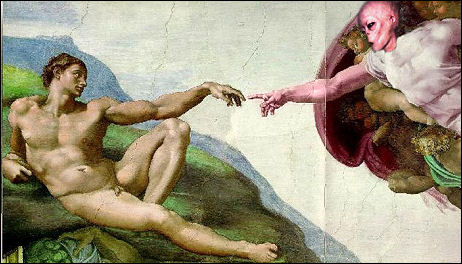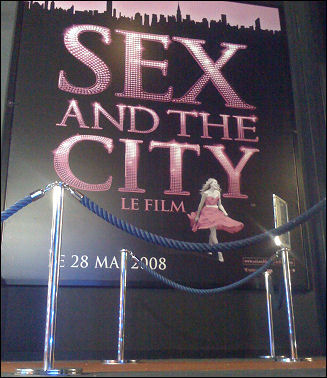Early yesterday evening on the way to meet friends for dinner in the 17th.
Nutty Cop
My idea is this: Eddie Murphy shouldn’t return as “Axel Foley” proper in the new, Brett Ratner-directed Beverly Hills Cop flick (the fourth), which will shoot sometime next year and come out in 2010. He should play Axel gone to seed, as a 375-pound prosthetic fat-ass. I know that Ratner and the team have to do something for the film not to seem like a creaky retread, and this would be that.
Yellow Peril
Houston, we have a problem. They can’t just put it all into a bag, take a space walk, give it a toss and let it float away?
The Real Thing?
A video “that purportedly shows a living, breathing space alien will be shown to the news media Friday in Denver,” according to a 3.28 story by Rocky Mountain News reporter Daniel J. Chacon.

Jeff Peckman, who, Chacon says, is “pushing a ballot initiative to create an Extraterrestrial Affairs Commission in Denver to prepare the city for close encounters of the alien kind” (in other words…a nutbag!) said “the video is authentic and convinced him that aliens exist.”
Peckman “said the general public will have to wait to see it because it’s being included in a documentary by Stan Romanek.” What? On top of which “no one will be allowed to film the segment with the extraterrestrial because there is an agreement in place limiting that kind of exposure during negotiations for the documentary.” Peckman is allegedly sitting on conclusive proof of the existence of an alien life form and he’s talking about contractual rights and whatnot?
An instructor at the Colorado Film School in Denver scrutinized the video “very carefully,” Chacon reports, “and determined it was authentic, Peckman said.” What instructor? Doe he have a name? My bullshit meter is doing somersaults.
Faux-Jungle Line
From this Matt Gross “Frugal Traveller” piece in the 5.28 N.Y. Times about doing Paris on a budget, a term I haven’t used before — “bobo,” which means bourgeois bohemian, as in ostensibly funky, soulful and tourist-free but not really. I should have popped out by now, being in the Urban Dictionary and all. Some of us are slower than others.
Third Go-Round?
First there was Scarlett Johansson as
And now, if you believe Jarett Wieselman‘s 5.27 Popwrap item, there are plans to film another Boleyn drama based on a book by Boleyn Girl author Philippa Gregory, called “The Boleyn Inheritance.” In this installment Johansson will play…kidding! But is there really that much interest in the Elizabethean maneuverings and shaggings by ruthless connivers and their pure-of-heart victims?
Been Here Before But…
In honor of the not-quite-15th anniversary of True Romance (it opened on 9.10.93 in the States, and 10.15.93 in Great Britain), Maxim has spoken to the principals — director Tony Scott, screenwriter Quentin Tarantino, stars Christian,Slater, Patricia Arquette, Gary Oldman, James Gandolfini, Dennis Hopper, et. al. — and assembled some good material.
Scott: “When I was directing The Last Boy Scout, my assistant was hanging out with this quirky guy named Quentin Tarantino, and he’d d be around the set. She said, ‘You gotta read his script.’ I said, ‘Yeah, right.’
Tarantino: “When you’re a nobody, it’s murder to get anyone to read your scripts. So my thing was making the first page fantastic, with dialogue that grabbed you right away. The original True Romance script started with a long discussion about cunnilingus. Most people said the script was racist and that the grotesque violence would make people sick. I told Tony, ‘Read the first three pages. If you don’t like it, throw it away.'”
Scott: “He gave me two scripts: True Romance, which was his first script, and Reservoir Dogs. I’m a terrible reader, but I read them both on a flight to Europe. By the time I landed, I wanted to make both of them into movies. When I told Quentin, he said, ‘You can only do one.'”
Precisely
Sarah Jessica Parker‘s Carrie Bradshaw “is the worst human being ever,” declares MCN columnist Noah Forrest in a longish piece about his mixed feelings towards HBO’s Sex and the City series, which carry over (trust me) into the film. “Hyperbole? Sure, but there’s a lot of truth to that statement and it has very little to do with how much Carrie has affected women all over New York City (I swear if I see one more dress with a bushy tail on it…) and everything to do with how she treats her friends on the show.
“My overarching feeling when I look back on all of the [HBO] episodes is that she is a selfish, self-centered opportunist with no regard for anybody else. She is the worst kind of ‘independent’ woman, [one] who loses herself in every relationship she becomes involved in and loses touch with all of her friends every time she enters into one of those relationships.
“It’s a problem that Carrie is a materialist too, but that is more of a societal issue because women look up to her and see her as something of an icon or role model. It’s amazing that some of the show’s most ardent supporters are women under the age of majority. I suppose it’s not the show’s fault, but if I were the producers I would wonder why my show about thirty-something women — and especially my main character — appeals so strongly to teenage girls.
“There are a lot of profound problems with the show, starting with its betrayal of its own premise: it purports to be about four single thirty-somethings who don’t necessarily eschew relationships in general, but find that they don’t need a man to prove their worth. At the end of the series, each woman has settled down with wealthy or handsome men (and in Carrie’s case, both). Maybe these gals didn’t love their beaus because of their wealth or their looks, but they sure were wealthy or they sure were good looking. The central thesis of the show is thus deflated by the final bow, which essentially says: sure, you can be happy on your own but it is better to have someone who can buy you shoes instead of buying them yourself.
“That is not to say that fantasy is a bad thing, but you don’t want to read a fairy tale and have the unicorn die of leprosy; no, you want the unicorn to fly, or whatever it is that unicorns do. The point being: Samantha’s character is a fantastical extrapolation of what a woman’s life could potentially be if she eschewed relationships with men in favor of casual sex. She also happens to be a world-class PR gal that is as much a tiger in the boardroom as she is in the bedroom.
“Is it possible this kind of woman exists? Yes, of course. But Samantha is designed as a character for a television show and isn’t a real person and what she was designed for was to be the logical conclusion of a life built around freedom and drive (both career-wise and sexual). She is like the female Gordon Gekko, except she would be more apt to say, “sex√ɬ¢√¢‚Äö¬¨√Ǭ¶is good.”
“The bottom line is that to have that character settle down, no matter what the reason, takes away the fantasy that the show has created. It takes that option away from the multitudes of women who watched the show and thought to themselves, ‘wow, I wish I could be more like Samantha,’ and instead reduces them to saying, ‘wow, I wish I had a boyfriend like Samantha’s.'”
Carrie’s Inferno
I’ve watched episodes of Sex and the City on HBO maybe five or six times, which obviously indicates I’m not a huge fan but also that I’ve found it agreeable enough from time to time. The movie version, which runs around two and a half hours, takes whatever it was that made the show half-palatable and just amplifies and gussies it up all to hell. I’ve been told that the movie is the show and that any perceived degradation is a judgment that begins and ends in my own head. Not so. The first hour of SATC is as garish and putrid and spiritually repulsive as can possibly be imagined without throwing up, and I was never so moved during those episodic HBO sojourns.

Wednesday, 5.28, 1:35 pm — taken during a short break from the film that I needed badly.
Each main character — Sarah Jessica Parker‘s Carrie Bradshaw, Kim Cattrall‘s Samantha Jones, Kristin Davis‘s Charlotte York and Cynthia Nixon‘s Miranda Hobbes — have their own story here. (Naturally.) Three experience the usual issues with boyfriends/husbands, but it’s all blah, blah, blah, blah, blah, blah. The last 90 minutes are a bit more tolerable than the first hour, but that’s like saying the visit to the dentist got better after he pulled the tooth with a pair of pliers.
The soul of this movie is infected with gross materialism, the flaunting of me-me egos and the endless nurturing of the characters’ greed and/or sense of entitlement. It’s all about money to piss away and flashy things to wear and lush places where the the girls lunch and exchange dreary confessional chit-chat. And this, mind you, is where millions of middle-class women in every semi-developed country around the globe live in their dreams. They’re going to this movie right now in multitudes. Sad. Really sad. Because SATC is crap through and through.
A few items back I called Sex and the City a Taliban recruitment film. All I know is that I felt ashamed, sitting in a Paris movie theatre, that this film, right now, is portraying middle-class female American values, and that this somehow reflects upon the country that I love and care deeply about. It’s a kind of advertisement for the cultural shallowness that’s been spreading like the plague for years, and for what young American womanhood seems to be currently about — what it wants, cherishes, pines for. Not so much the realizing of intriguing ambitions or creative dreams as much as wallowing in consumption as the girls cackle and toss back Margaritas.
The HBO show’s dialogue, frequently written by Michael Patrick King, who directed and wrote the screenplay for the film, never riled me that much. But I was wincing at it during today’s screening at the UGC Les Halles. Some concepts play better on the tube; amplifying them only pushes the flaws into your face. All I know is that the faux-splendor of the movie — the insipid Marie Antoinette-ishness of the damn thing with the look-at-me clothes and sets and nouveau-riche ickiness of the apartments and restaurants — felt to me like a kind of hell.
“I’m watching this of my own free will,” I muttered to myself a few times, “and with my own money.” To cope with these feelings of remorse and repulsion, I staged a mini-rebellion somewhere between the halfway and two-thirds mark by heading out to the lobby for a Diet Coke, a cafe au lait, a little i-Phone catch-up and to take some photos of the huge SATC standee. It helped.
I’ll tap out some more after I come back from dinner this evening. We’re having our first day without rain here, and life is short. To hell with this movie, and scratch any woman who says she liked it off the list. For anything.

